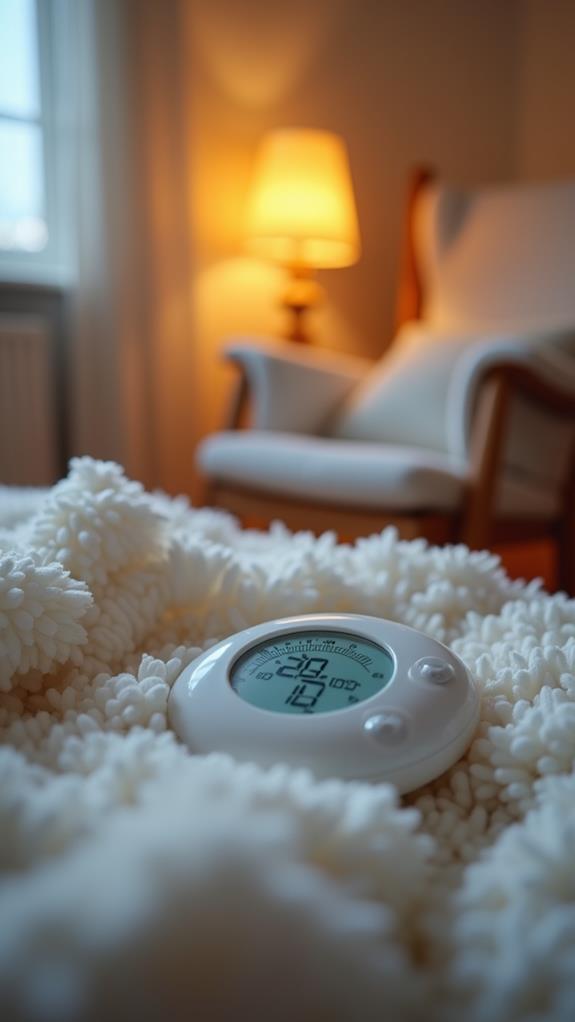Teething can feel like a wild ride, but you’ve got this! Start with some awesome teething toys that’ll take the edge off; silicone ones are the best! Try cold washcloths or chilled snacks like frozen fruits to soothe sore gums. A gentle gum massage can work wonders too! If you’re up for it, check out teething gels—just talk to your doc first.
Don’t forget to create a cozy routine with snuggles and lullabies. Keep an eye on that temp, and if anything seems off, definitely consult your pediatrician. Stick with me, and you’ll uncover even more effective tips!
Key Takeaways
- Use teething toys or rings made from safe materials to provide relief through chewing and distraction.
- Apply a cold washcloth to the gums for a soothing, numbing effect.
- Offer chilled fruits or vegetables in a mesh feeder for healthy relief from teething pain.
- Gently massage the baby’s gums with clean fingers to alleviate discomfort and promote bonding.
- Establish a comforting routine, including calming baths and lullabies, to help ease teething distress.
Use Teething Toys

When your baby’s teeth start coming in, teething toys can really help ease their discomfort. You know the drill—fussy baby, drooling like a fountain, and those tiny fists trying to gnaw on anything in sight. That’s where silicone toys come in! These little gems are safe, durable, and oh-so-satisfying for your little one to chew on. Plus, they’re easy to clean.
Look for teething toys with textured surfaces. Those bumps and ridges not only feel great on sore gums, but they also keep your baby entertained. It’s like a mini massage for their mouth! You can even find some that are colorful and squeaky. What kid doesn’t love a toy that makes noise?
Just make sure you supervise your baby while they’re teething. No one wants a choking incident because they got a little too excited about their new favorite toy.
And hey, don’t be surprised if they develop a strong attachment to their teething buddy. It’s basically a rite of passage!
Apply Cold Compresses
Applying cold compresses can be a breakthrough for soothing your baby’s teething pain. When those little teeth start pushing through, it can feel like your baby’s mouth is a wrestling ring. That’s where cold packs come in! Just think of them as tiny ice packs of relief.
Grab a clean cloth, dampen it, and pop it in the fridge or freezer for a bit. The cold pack benefits are huge! Not only does it numb the discomfort, but it’s also a great way to distract your little one from the pain. You can apply the compress directly to their gums, or let them chew on it. Just make sure it’s not too cold—nobody wants a teething baby with frostbite!
These soothing techniques can be a game changer. Your baby might just look at you like you’re a superhero! Plus, it’s a simple, quick fix that requires no fancy tools or gadgets. Just you, a cloth, and a little ice magic.
Offer Chilled Snacks

One of the easiest ways to ease your baby’s teething pain is by offering chilled snacks. Trust me, your little one will appreciate the cool relief. Frozen fruits like bananas, blueberries, or peaches can be a lifesaver. Just throw them in the freezer for a bit, and you’ve got a tasty treat that helps soothe sore gums. Plus, they’re packed with vitamins, so you’ll feel like a parenting rockstar!
Another fun option is yogurt pops. Simply blend some yogurt with fruits and pour the mixture into ice pop molds. Pop those babies in the freezer, and voilà! You’ve got an invigorating snack that can distract your baby from the discomfort. Just make sure to supervise your little one as they enjoy their icy delight. You wouldn’t want them to turn into a mini disaster zone!
Offering chilled snacks not only helps with teething pain, but it also introduces your baby to new flavors. Who knew teething could be a culinary journey?
Massage Baby’s Gums
Gently massaging your baby’s gums can provide instant relief from teething pain. It’s like giving your little one a mini spa day, and who doesn’t love that?
Using simple gum massage techniques can help ease their discomfort while also bonding with them. Plus, it’s a great way to distract them from that gnawing ache!
Here are some easy steps to get you started:
- Wash your hands – Seriously, clean hands are a must. You don’t want to add to their problems!
- Use your finger – Wrap your clean finger in a soft cloth or use a baby toothbrush. Apply gentle pressure to the pressure points along their gums.
- Be gentle and rhythmic – Rub in small circles. Pretend you’re giving them a tiny, soothing massage. Trust me; they’ll appreciate it!
Just remember, this isn’t a wrestling match. The goal is to make your baby feel calm and secure.
Keep it light and fun! Your baby might even giggle a little, and that’s the best sound ever. Happy gum massaging!
Try Teething Gels
Teething gels can be a quick and effective way to alleviate your baby’s discomfort during this challenging time. When those little teeth start pushing through, you might feel like a superhero, ready to save the day! Many teething gels out there use natural ingredients, which means you can feel good about what you’re putting in your baby’s mouth.
To get the most out of the gel, you’ll want to perfect some application techniques. First, wash your hands—no one wants a germ party in your baby’s mouth! Then, squeeze a small amount of gel onto your clean fingertip. Gently rub it onto your baby’s gums, focusing on the areas where those pesky teeth are coming in. Just a little bit goes a long way, so don’t overdo it!
But don’t forget to keep an eye on how your baby reacts. If they seem extra fussy or you notice any odd reactions, it might be time to switch brands or consult your pediatrician.
Teething gels can be a lifesaver, but always choose wisely! You’ve got this, and your baby will thank you (eventually)!
Keep Baby Distracted
Often, keeping your baby distracted can be a life-changing factor when teething pain strikes. When those little teeth are pushing through, your tiny tot might be a little more cranky than usual.
So, let’s turn that frown upside down with some playful activities and engaging toys!
Here are three fun ideas to keep your baby entertained:
- Sensory Play: Fill a shallow tray with safe items like water, rice, or even pasta. Let your baby investigate different textures. Just be ready for a little mess—it’s all part of the fun!
- Music and Movement: Put on some catchy tunes, and have a dance party! Babies love to move, and shaking those tiny bodies can help lift their spirits. Bonus points if you join in the groove!
- Storytime Journeys: Grab a few colorful books and read aloud. Use silly voices and make it interactive. Your baby won’t even notice the teething pain while they’re enchanted by your storytelling.
Utilize Herbal Remedies

When distraction techniques aren’t enough, herbal remedies can provide a natural way to ease your baby’s teething pain. You might be wondering, “What’s safe and effective?” Well, let’s explore!
Start with a soothing herbal tea. A chamomile infusion can work wonders; it’s like a warm hug for your little one’s gums. Just make sure it’s cooled down before you offer it!
Clove oil is another superstar. A tiny dab can numb the area and give your baby some relief. Just remember, a little goes a long way!
You could also try peppermint leaves, which have an invigorating zing that might help calm your baby’s cranky mood.
For a fun DIY remedy, whip up some ginger paste. Mix it with a bit of water, and you’ve got a spicy solution that can ease that teething discomfort.
Create a Comforting Routine
Creating a comforting routine can make a world of difference for your baby during teething. Trust me, when your little one’s in pain, a little predictability can go a long way.
Think of it as setting up their very own cozy bubble where they can chill out and feel safe.
Here are three simple ideas to help you create that routine:
- Bedtime Rituals: Start winding down with a calming bath. Add some gentle baby soap and watch those tiny toes splash around. It’s not just for cleanliness; it’s fun!
- Soothing Sounds: Soft music or white noise can work wonders. Play those lullabies or nature sounds that’ll help drown out any fussiness. You’ll both appreciate the peace!
- Snuggle Time: After the bath and music, cuddle up with a favorite blanket or stuffed animal. Nothing says comfort like a good snuggle session. You can even read a cute bedtime story!
With these little tweaks, you’re not just helping your baby cope; you’re creating a lovely routine that both of you’ll cherish.
Monitor Baby’s Temperature

During teething, it’s important to keep an eye on your baby’s temperature. You might notice that your little one is a bit cranky, drooling like a leaky faucet, or gnawing on everything in sight. These are all common teething symptoms.
But sometimes, that fussiness might come with a little fever. So, grab that trusty thermometer! Regular temperature checks can help you figure out if your baby’s discomfort is just from teething or if there’s something else going on.
A slight rise in temperature is normal during teething, but if it climbs past 100.4°F, it’s time to pay attention.
Remember, a warm forehead might just mean your baby’s working hard to cut those new pearly whites. But it could also signal a need for some extra cuddles or a cool washcloth to soothe their gums.
Just keep your cool and don’t panic! You’re not alone in this teething journey.
Consult a Pediatrician
It’s always a good idea to consult a pediatrician if your baby’s teething symptoms seem severe or unusual. Trust me, those tiny teeth can cause big drama!
If you notice anything out of the ordinary, don’t hesitate to make that call.
Here are a few signs it might be time to seek some pediatric advice:
- High Fever: If your baby’s temperature is hotter than a summer’s day, it could be a sign of something more serious.
- Diarrhea: A little drool is normal, but if it turns into a full-on poop explosion, it’s worth checking in with the doc.
- Refusal to Eat: If your little one suddenly turns their nose up at food they usually love, it might be more than just teething discomfort.
Conclusion
So, there you have it! You’ve got a toolbox full of tricks to help soothe your little one’s teething woes. Remember, every baby’s different, so it might take some trial and error to find what works best. Just keep your chin up and don’t be afraid to experiment a bit. With a little patience and creativity, you’ll be back to giggles and grins in no time. After all, this too shall pass—just like those pesky teeth!
Join our list
Subscribe to our mailing list and get interesting stuff and updates to your email inbox.

